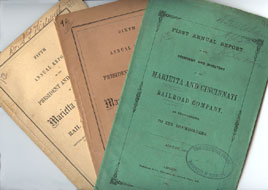|
Marietta and Cincinnati Rail Road Company. Annual Report
of the President and Directors. Cincinnati, Ohio: Moore, Wilstatch,
Keys & Co., 1855–1856; London, Eng.: McKewan & Co.,
1861.
Railroads played an important part in the country’s expansion
westward and were integral to the development of Ohio’s economy
in the nineteenth century. The towns of Marietta and Cincinnati,
both established in the 1780s, were already becoming commercial
centers due to their locations on the Ohio River. After the mighty
Baltimore and Ohio Railroad Company was chartered in 1825, numerous
towns clamored to become subsidiary or spur lines as the railroad
extended westward. With funding secured from the Ohio legislature
for projects that were attractive to the officers of the B&O,
this main eastern line was extended to Marietta. In 1851, the charters
for a Marietta-to-Athens line and the Belpre-to-Cincinnati line
were consolidated to form the Marietta and Cincinnati Rail Road.
 But
there were conflicts as the line was developed. A plan by the Hillsborough
and Cincinnati Rail Road to build to Belpre in southeastern Ohio
generated heated conflict until a settlement was reached in 1854.
The settlement is detailed in the Fifth Annual Report (1855),
which includes the bottom line Expenditure and Cost as an astonishing
“$10,046,126.12, being an average of $34,334 per mile.”
Similarly, a plan by the B&O to build from Belpre through Athens
was defeated in the Ohio statehouse by actions of the Marietta and
Cincinnati officials. In addition, during these years of growth
and turmoil, incessant rains washed out large sections of track,
finally forcing the company into bankruptcy in 1858. But
there were conflicts as the line was developed. A plan by the Hillsborough
and Cincinnati Rail Road to build to Belpre in southeastern Ohio
generated heated conflict until a settlement was reached in 1854.
The settlement is detailed in the Fifth Annual Report (1855),
which includes the bottom line Expenditure and Cost as an astonishing
“$10,046,126.12, being an average of $34,334 per mile.”
Similarly, a plan by the B&O to build from Belpre through Athens
was defeated in the Ohio statehouse by actions of the Marietta and
Cincinnati officials. In addition, during these years of growth
and turmoil, incessant rains washed out large sections of track,
finally forcing the company into bankruptcy in 1858.
In 1860, the railroad resumed operations as the Marietta and Cincinnati,
Reorganized, only to be stuck by the outbreak of the Civil War.
Included in the above photo is a copy of the First Annual Report
of the President and Directors of the Marietta and Cincinnati Railroad
Company, as Re-Organized. This report, dated 1861 and printed
in London, documents the shift of the directorship to the European
bondholders due to its financial disarray and the “severe blow
struck at American credit by the extensive rebellion in the Southern
States. The consequence was an utter destruction of the credit of
all unfinished railways and other public enterprizes in the United
States.” A “Trustees’ Loan” was disposed of
via costly mortgage bonds, and the company continued to operate
under the reorganized board based in London.
The Marietta and Cincinnati Rail Road Company remained afloat and
running until 1883, when the company once again went bankrupt. This
was the final blow, and the Baltimore and Ohio quickly stepped in
and assumed complete control of the tenacious line.
|